Since becoming interested in meditation several years ago, I've been following the increasing amount of scientific attention devoted to it in recent times. Researchers have concluded that meditation 'grows' and 'charges' the brain, and that long-term meditators have a higher life-expectancy and have displayed "the highest activity in the brain centers associated with positive emotions that had ever been measured".
In the interest of balance, meanwhile, King Missile provide the counterpoint with their song 'Meditation is Boring'. And very occasionally I'd be inclined to agree with them on that, although I think it is more frustration than ennui that arises on a bad day.
Nestled amongst a group of arid hills sits the Dhammathali Vipassana centre (one in a global network of centres; details at http://www.dhamma.org/), right next to a small ashram of self-described crazy monks, itself unrelated to the centre. At the end of the same road, a kilometre distant is the Galta Temple (also known as the Monkey Temple for its simian residents). I found out only two days prior that there was a centre in the area, and now I am at its gates.
The compound that is to be my home for the next 3 weeks is brimming with life; hundreds of pigeons feeding take flight as I pass and I feel the down-draught of so many wings. Dozens of peacocks nestle high in the trees and I am astonished to see these great birds also take flight. Cows graze and meander.
The staff welcome me, and after registering and depositing my luggage in my room, I am required to leave my valuables, gadgets/distractions and reading/writing materials in a vault. This first day is relaxed and I meet some other fellow meditators, including several others who have come from Europe. In the evening the 120 or so meditators enter the largest Dhamma hall to be instructed in Anapanna 'Awareness of Breathing' meditation.
There is a widely-held misconception that meditation means emptying the mind of all thought by effort of will, which is probably impossible. Actually, in a nutshell the idea is simply to sit and keep your awareness on some aspect of your experience until a state of deep concentration results. This is similar enough to Zazen, which I've practised sporadically over the last several years.
Conscious of the next day's early start, most go directly to bed at 9 p.m.
The gentle reverberations of a great bell tug me from my dreams at 4 a.m. on the first day of meditation; the first day of Noble Silence. Handbells approach, pass and fade before returning again. I wash with a bucket of cold water in my bathroom and then settle down to meditate in my chamber. After 2 hours the bell sounds again for breakfast, and as I queue with the others in the male canteen. I am pleased to find porridge, bananas and hot massala chai on offer.
After breakfast is a 3 hour block of meditation, with a 5 minute break in the middle, more sitting than I am accustomed to, and it drags a bit. Lunch, the last substantial meal of the day, is traditional Indian vegetarian fare, and I over-indulge before taking a nap in my room to be awakened by the bell at 1 p.m. for the afternoon's 4 hours of meditation, again with intervals between the 3 sessions.
As a bit of a stimulation junkie (thank you, Internets!) I find it difficult to keep my attention on such a vague and normally ignored sensation as the passage of air through my nostrils. I find that the effort to do so is worthwhile though, as I have moments, then seconds and later on even minutes of undisturbed concentration. The alternative for me (besides sleeping) when the meditation just isn't happening, is an unsufferable agitated boredom, although even this seems to lessen as the course goes on.
Dinner was a gruel with savoury puffed rice, peanuts and dried peas. There was a bit of free time in which many of us stood watching the monkeys, their swinging from branch to branch an apt metaphor for my own 'monkey mind' which I experienced flitting uselessly from grasping fantasy to worry and everything between when my concentration failed. And worst of all was to start internally counting down until the session's conclusion.
Practice resumed with another hour of meditation, followed by a video 'discourse' by the S. N. Goenka, the founder of this Vipassana organisation. This took the form of a secularised distillation of the core precepts and practices of Buddhism, and from a critical/scholarly perspective displayed an acceptable degree of rigour overall.
After a final 30 minutes' meditation, we broke for the night at 9 p.m.
And that was the basic template for the following 8 days. An atmosphere bearing no little resemblance to a minimum security prison, a daily 10 hours of meditation, hearty but simple meals, some rest, and just enough time to take care of daily amenities in the gaps. Each evening's discourse introduced new ideas, funny anecdotes and a little more of a skeletal but fairly sound Buddhist doctrine, which was presented in such a way as to be compatible with any religion, metaphysic or lack of.
Keeping silence was not difficult, at least for me. I was led to draw conclusions on the character of my fellows based on only visual cues. Some very subtle forms of communication persisted - mainly smiles and hand gestures.
The fourth day at last introduced Vipassana meditation, our concentration deemed havng developed sufficiently over the preceding days. The awareness was now of all sensations in the body, with the intent of becoming attuned to more and more subtle sense perceptions. In our first session we were instructed not to move a muscle for the entire 90 minutes, with the result I was shaking by the end of the session with the effort, and barely able to walk afterwards. I decided that this cushion-sitting was not for me and that I was risking damage to my joints. When my request for a chair was denied and I was told to change position but to the minimum extent practiceable, I became infuriated and pondered leaving the course.
The next morning though, I awoke feeling 'come what may' and found the cushion-sitting a little more tolerable. And in spite of this initial difficulty and some scepticism, I found that an increased sensitivity throughout the body is precisely what developed. At times when I managed to attain the required concentration, a 2 hour session could pass by effortlessly. On just a few occasions I had prolonged feelings of absolute peace, an incredible bliss. We were warned not to crave or become attached to this state, just as were advised to refrain from feeling aversion to the pain and difficult moments when the monkey mind left one feeling it was all too difficult a task, reforming this unruly mind.
At all times we were to maintain perfect equanimity (non-judgemental acceptance) towards the sensations - intense or subtle, painful or pleasant - remaining mindful of their impermanence (or transience), alike unto all phenomena. Likewise we were to accept the times when concentration eluded us, and not condemn ourselves.
I continued to become more comfortable in the physical act of sitting, but the quality of meditation remained variab\e up until the 9th day, when lack of sleep and sharp pain in my shoulders (a hangover from my computer hacker days) led me to mostly abandon the effort. Now, though, even when not meditating I found the long sessions somehow much more bearable, as if I had acquired more patience and acceptance.
With the 10th day, we broke Noble Silence and finally got to know the people we'd sat beside for the last week and a half. I was surprised to find that I was not alone in doubting some aspects of the discourse, and yet that we all agreed that the meditation practice itself seemed valuable and highly effective. The practice must be maintained after the retreat for any great benefit to be seen however.
Students were invited to give an optional donation before they left on the 11th morning. Perhaps because I arrived by bicycle, I was invited to stay on a few days in the centre by a very friendly volunteer. This was precisely what I had wanted to do anyway. I spent the next nine days cleaning the centre, preparing newsletters for sending out, checking the facilities and preparing them for the next course. I got to know the 'Dhamma Workers' more and we had a lot of laughs. We continued to meditate 3 hours per day together. I continued to over-indulge in the delicious food (encouraged by the kitchen staff), watched the 30 or so monkeys leave each morning to return in the evening, and took walks up the nearby hills.
By luck I managed to tweak my bicycle's derailer back to a state of happiness the day before leaving. And so, on the 1st day of 2011 I bid farewell to all and cycled westward....
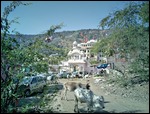

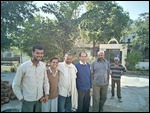



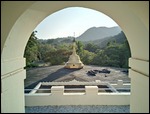
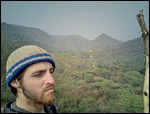

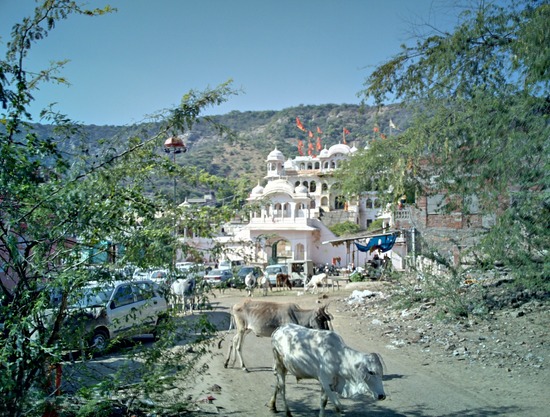
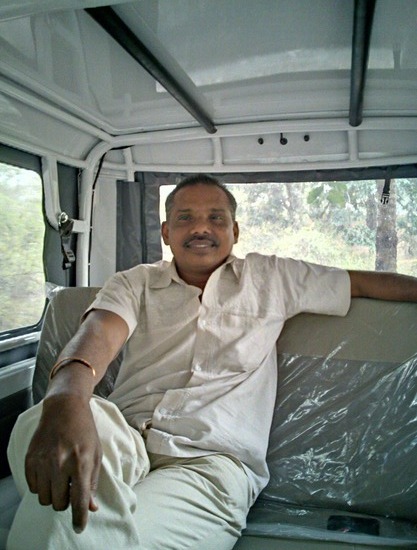


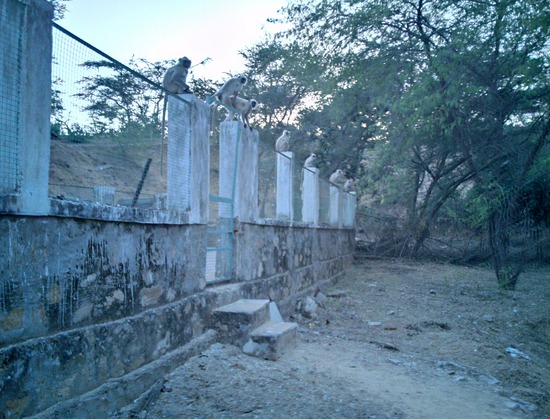

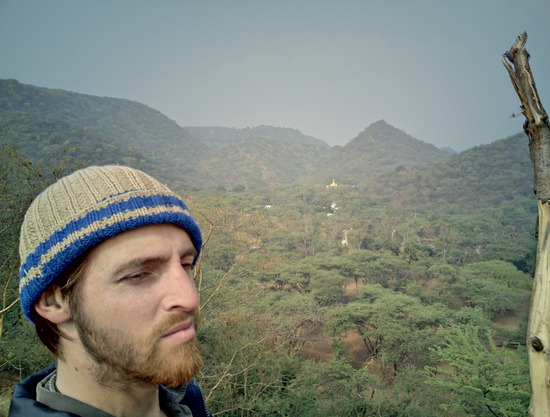
Comments